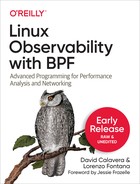Foreword
As a programmer (and a self-confessed dweeb), I like to stay up to date on the latest additions to various kernels and research in computing. When I first played around with Berkeley Packet Filter (BPF) and Express Data Path (XDP) in Linux, I was in love. These are such nice tools, and I am glad this book is putting BPF and XDP on the center stage so that more people can begin using them in their projects.
Let me go into detail about my background and why I fell in love with these kernel interfaces. I was working as a Docker core maintainer, along with David. Docker, if you are not familiar, shells out to iptables for a lot of the filtering and routing logic for containers. The first patch I ever made to Docker was to fix a problem in which a version of iptables on CentOS didn’t have the same command-line flags, so writing to iptables was failing. There were a lot of weird issues like this, and anyone who has ever shelled out to a tool in their software can likely commiserate. Not only that, but having thousands of rules on a host is not what iptables was built for and results in performance side effects.
Then I heard about BPF and XDP. This was like music to my ears. No longer would my scars from iptables bleed with another bug! The kernel community is even working on replacing iptables with BPF! Hallelujah! Cilium, a tool for container networking, is using BPF and XDP for the internals of its project as well.
But that’s not all! BPF can do so much more than just fulfilling the iptables use case. With BPF, you can trace any syscall or kernel function as well as any user-space program. bpftrace gives users DTrace-like abilities in Linux from their command line. You can trace all the files that are being opened and the process calling the open ones, count the syscalls by the program calling them, trace the OOM killer, and more…the world is your oyster! BPF and XDP are also used in Cloudflare and Facebook’s load balancer to prevent distributed denial-of-service attacks. I won’t spoil why XDP is so great at dropping packets because you will learn about that in the XDP and networking chapters of this book!
I have had the privilege of knowing Lorenzo through the Kubernetes community. His tool, kubectl-trace, allows users to easily run their custom tracing programs within their Kubernetes clusters.
Personally, my favorite use case for BPF has been writing custom tracers to prove to other folks that the performance of their software is not up to par or makes a really expensive number of calls to syscalls. Never underestimate the power of proving someone wrong with hard data. Don’t fret, this book will walk you through writing your first tracing program so that you can do the same. The beauty of BPF lies in the fact that before now other tools used lossy queues to send sample sets to user-space for aggregation, whereas BPF is great for production because it allows for constructing histograms and filtering directly at the source of events.
I have spent half of my career working on tools for developers. The best tools allow autonomy in their interfaces for developers like you to use them for things even the authors never imagined. To quote Richard Feynman, “I learned very early the difference between knowing the name of something and knowing something.” Until now you might have only known the name BPF and that it might be useful to you.
What I love about this book is that it gives you the knowledge you need to be able to create all new tools using BPF. After reading and following the exercises, you will be empowered to use BPF like a super power. You can keep it in your toolkit to use on demand when it’s most needed and most useful. You won’t just learn BPF; you will understand it. This book is a path to open your mind to the possibilities of what you can build with BPF.
This developing ecosystem is very exciting! I hope it will grow even larger as more people begin wielding BPF’s power. I am excited to learn about what the readers of this book end up building, whether it’s a script to track down a crazy software bug or a custom firewall or even infrared decoding. Be sure to let us all know what you build!
